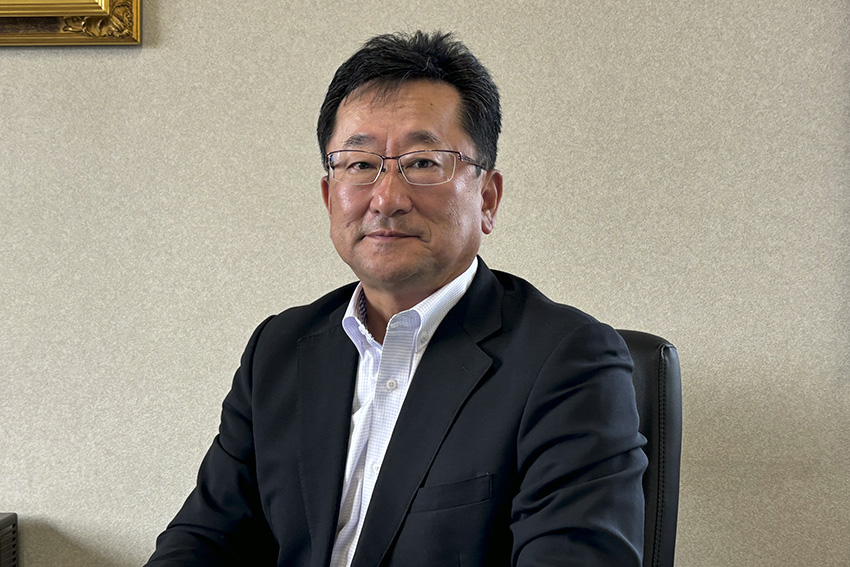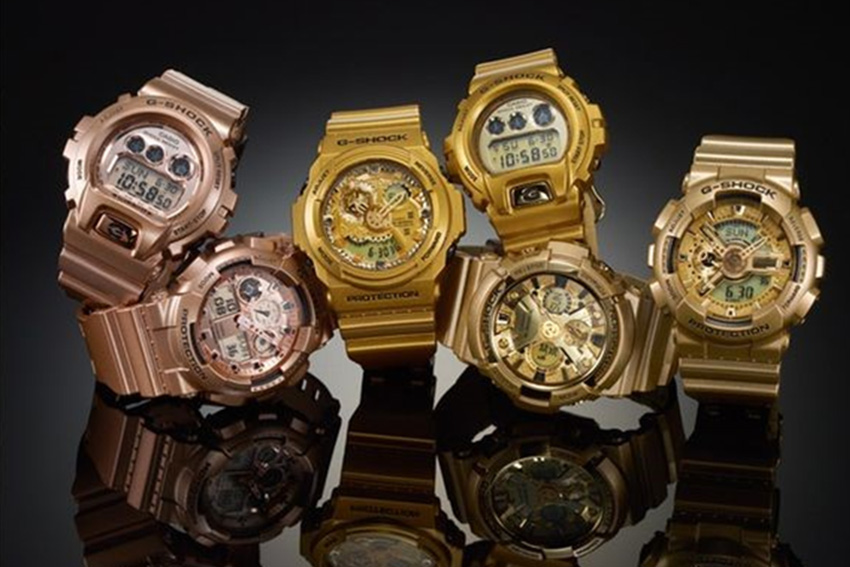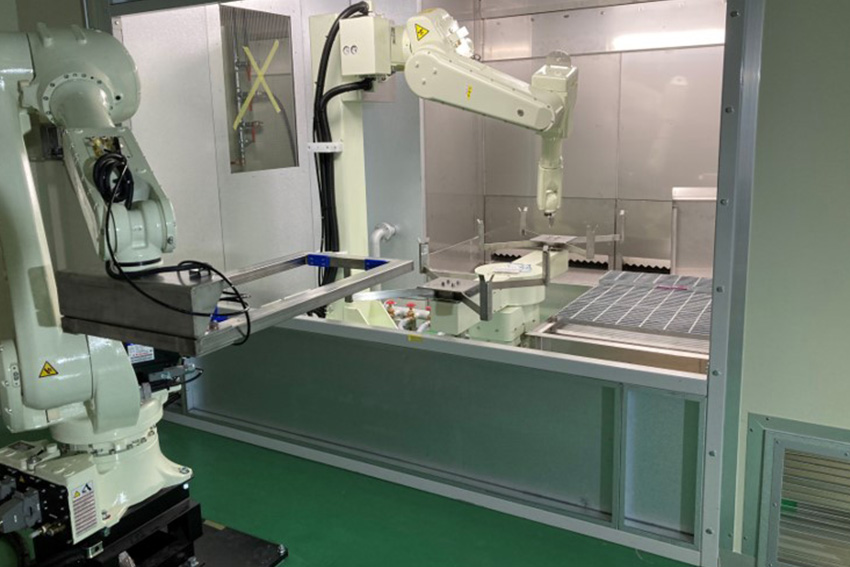With over 50 years of experience designing and manufacturing paint-related products and equipment, Sugata Shoji is revolutionizing multiple different industries with their emphasis on beauty, function, and protection. In this interview with Mr. Kiyofumi Kanno, we explore various parts of Sugata Shoji’s operations including, surface treatments, paint applications, sustainability, and overseas expansion.

Many experts believe that now is an exciting time for the Japanese industry. On the one hand, there are significant supply chain realignment strategies with governments trying to increase onshore production and reduce country risk, forcing groups to redesign their supplier networks. Do you agree with this sentiment, and do you believe the current situation poses more challenges or opportunities for companies like yours?
I agree that Japanese manufacturing has never been in such a good position as we see now, and indeed, it’s at quite an exciting juncture, especially given the recent supply chain disruptions and the shifting global economic landscape. We do see the advantages of having a Japanese yen at its historic low. But my answer would be more related to the domestic presence of Japanese manufacturing and using that weakened yen to produce something from Japan and maybe later on increase exports. But the situation was slightly different three or five years ago because most Japanese companies were pushed to establish some facilities outside of Japan. So, from my perspective, I see that Japanese manufacturing companies are now focusing on the domestic market rather than giving preference to overseas expansion.
Some big overseas semiconductor companies illustrate this. For example, we see TSMC building a new facility in Kumamoto prefecture. It also highlights how Japanese companies’ advanced technologies and innovation bring these companies to localize their production in Japan rather than allow Japanese companies to take full strength and go overseas.
We have facilities overseas, in Thailand and Vietnam, and when I go there, I see that recently, there have not been many Japanese companies. Maybe some tourist or food-related industries will go to foreign markets in Southeast Asia, but not many manufacturing companies. Most of them are coming back to Japan.
How have you seen the role of traders evolve over the last ten years, and what do you think will be the next steps in the evolution of companies such as Sugata?
Domestically, we still stay on the conservative side. We still implement the same functions and features as a trade company, acting as a middleman between manufacturer and customer. Still, we definitely see the need to introduce added-value services. When we talk about overseas expansion specifically, anybody can open up the home page and do business on a digital basis. Anyone can find a supplier from Japan and procure from them directly, avoiding the costs of trading companies. This became a necessity for us to introduce added value services, including our know-how and our engineering capabilities. Upskilling the workforce is something that we are very strong at, and that’s why we opened facilities in Thailand and Vietnam, to be close to the customers because there are a lot of Japanese companies that localize production. They are services that are provided for free, but they give us traction from the customers and get our name on the map to attract more customers. Because of those activities, we currently have a customer portfolio all around Southeast Asia and in America and South Korea, for example.
Another need for specialized trade companies like ourselves is to provide engineering knowledge and people who can connect the dots because the paint industry is quite specialized. It’s strange that paint manufacturing companies that make liquid paints sometimes don’t even know which kinds of equipment are needed when applying the paint on some surfaces. For that reason, these companies need us to connect with them. For example, specialty paint companies don’t even know which companies need their products or which products they are being used with, so we play a crucial role between these kinds of parties so they can benefit from mutual business together. In that way, specialized trade companies like ourselves are still needed.
In Japan, the paint market is very specialized and may be one-of-a-kind compared to foreign markets. One big difference between the Japanese and foreign paint industries is that each end usage requires a particular kind of paint, and only a specific company can handle that need. For example, automotive repair, construction, electric appliances, and industrial applications. These would require specific paint manufacturing companies and, likewise, paint manufacturing equipment companies, giving us insight into the technology and engineering capabilities of each industry or each paint usage. We cannot say the same about foreign markets because there we see, for example, manufacturing companies may do construction paint at one site, and at the same site, they are also doing electrical paint or another paint related to that construction. That gives us an advantage when we talk to foreign companies because we already have the knowledge that we accumulated here in Japan, and we have better customer engagement.
Regarding foreign companies, is there a significant market opportunity now for a German or American paint maker to enter the Japanese or Southeast Asia market, where Japan has traditionally dominated, or is the market fully saturated already with the existing players?
Maybe some foreign paint manufacturing companies could get into the Japanese market, but the market is already mature and fully occupied by some local players here. Perhaps they have a chance with collaboration and partnerships. We saw examples like that, where some foreign companies have some products that Japanese companies don’t have, and maybe they could work in cooperation with local companies.
Your firm today is present across a variety of sectors. You have paints for industrial use. You also have paints for construction, with specific properties, like being waterproof or soundproof. You also have automotive repair paints and paints for other specific applications. How are you able to cater to so many different industries?

This is our philosophy as a company. The company’s motto has been like that since our establishment. Our founder, back in the early days, had a message for all the salesmen to not focus on just one particular strategy and to not go in just one direction, but rather to diversify and be flexible to customer needs. It’s been 54 years since we were established, and it has always been like that. We try to tackle different industries. Now, of course, we cover automotive repair, construction, industrial applications, and many more industries because of that philosophy.
Our annual sales amount is JPY 2.5 billion, combining domestic and overseas results. We have a split between construction and industrial applications, typically 50-50.
We are innovative, with technology and know-how. We are also customer-focused. We provide a solution for any application that customers would like paint applied to. For example, overseas, there’s been an increase in the variations of customers related to the construction industry, and that’s why the knowledge we gain here in Japan allows us to have a wide selection of paints suitable for metal, plastic, wood, and different features. For example, anti-corrosion or waterproof thermal insulation is applied to roofing.
Could you give us an example of a challenging request from a customer who needed a specific type of paint that was perhaps not available on the market but that you were able to solve?
It’s not something for which I can give one specific example. Most customer needs can be considered unique to us, but we always try to fulfill our best features for the customers. It all starts with design. When the customer designs the production line, he comes to us, and we help determine equipment, procurement, and what kind of paint should be applied. It starts with the needs of the customer. They come to us and say, for example, that the capacity of a production line would be one product per minute. That’s just an example. In this kind of timeframe, you would have to apply the paint on the product, so in that way, every time the criteria is different. We try to introduce the best possible solution every time.
Looking at the future, is there a particular sector that you believe has the highest growth potential, and do you plan to diversify your sales into new industries perhaps?
Not really, because we already cover pretty much everything. It’s not like we are pursuing some new applications; rather, we are going in-depth on what we have right now, navigating the evolving business landscape to drive value for the customer.

Sustainability or environmental initiatives would have to be considered, of course, for many reasons. Regarding that, powder coating is one product that is growing and is expected to grow more. In terms of sustaining the environment, many companies, especially in the US and Europe, already are applying powder coating, but unfortunately, we cannot see many companies using it in Southeast Asia or Japan. We emphasize and propose to our customers the necessity of a smaller environmental footprint, so we are promoting sustainability right now.
When we talk about paints, there are two significant environmental challenges to overcome. First is production. A lot of paints still use petroleum-based materials. The second is disposal. Many companies either don’t use all the paint or don’t dispose of it in the most eco-friendly manner. How does your company address these two environmental challenges, and as a trader with the network that you have, how do you help your customers deal with specific challenges, such as disposal, for example?
Ohashi Kagaku is one of the companies that we are cooperating with in introducing biomass-based paints, which are more eco-friendly. We also invest in circle economy practices, educate people about proper paint disposal, and promote this kind of circular production responsibility about which paints they use. These activities may lead to increasing our portfolio, answering your previous question, and even becoming a manufacturing company to help reduce the environmental burden. Creating more eco-friendly materials could create a space for us to go to an area that we never thought about going to. So perhaps we can see ourselves from that point of view and become not just a specialist trader, but also become a manufacturing company.
You’ve been present in Thailand since 2014 and your latest oversea expansion was in 2019 in Vietnam. Why did you decide to focus on these two markets, and how has your performance been in each place?
Actually, before we went to Thailand and Vietnam, we went to China around 30 years ago. That was necessary because we were pretty much shipping a 40-foot container every month to China. That was the capacity back then and paint was needed for furniture and Buddhist altars, for example. And I was actually doing that activity back when I was working for the company 30 years ago. And, at one time, we were kind of saved by Casio because they started to produce their G-Shock product in Thailand. At the same time, we had a plunge in the Chinese market because we refused to open a legal entity in China since I felt like it was risky when there are so many regulations that only Chinese people understand. Because of that, we started to get away from China and we started to downscale our sales there. And so we thought about another country, which happened to be Thailand. At the same time, we had good connections here in Japan with Casio, so they asked us to do business in Thailand.
Good results bring even better results, so when we started doing business with Casio, word spread about our company and the rest is history because we started to work with Sony, Nikon, Canon and other globally famous companies in Thailand.
And the way we entered Vietnam five years later was actually kind of accidental because Vietnam and Thailand are very close to each other. And I have a friend there who knew a company that also specialized in paint and this friend recommended we drop by Vietnam on the way back to Japan and enjoy the country. So I went there, without even thinking of doing business there and my friend mentioned that there was a company there that was struggling, that needed paint solutions there. So I just drove by, during vacation, and I talked to them, and then they happened to make a massive purchase of equipment, which was finalized right there on the spot. We were blessed by the situation because usually how things happen is that some company decides to open an office in a country, even though it’s kind of risky, with no promise that you’re going to have suitable sales activities, but we had the opposite experience because first we had a sales contract and then we sort of needed to open an office there.
It turned out to be a good strategy because if you look at the Japanese companies that localized production in the early days, over 50% of them are having problems. Maybe the strategic partners were wrong or maybe they’ve done something wrong, and some companies are actually looking at us and saying maybe we did something right and they’ve got to do the same because we started off with signing the contract and solidifying the business before we actually started to go and establish company operations there.
As you look at Vietnam and Thailand today, they’re becoming increasingly strategic locations with the supply chain realignment we talked about and the trade dispute between the US and China. A lot of American, European, and even Chinese manufacturers are now moving their production away from China to ASEAN countries in order to benefit from cheap labor and be compliant with new trade regulations. With this trend in mind, how do you expect your international business will grow over the coming years?
We are living in a high-paced society that is changing and evolving very rapidly, so in that respect, we are safe for now with the business in Thailand and Vietnam, because many companies are localizing their production and need paint related services. Maybe in the next five years we’re going to be okay with stable business that we can expect from this region. But we are living in a rapidly changing world and we see activities happening in the other regions, because of the cheaper labor force and the special demands of those markets. We see that Mexico is escalating. India may be next on the list. In Africa, US companies already have exposure and have a presence, so we may take a closer look at other markets while also doing business in Southeast Asia.
As a trading company, you obviously always look to bolster your portfolio of brands that you’re working with, which are predominantly Japanese companies like Okitsumo, Kansai Paint, and Nippon Paint. Are you looking for more foreign partners and brands that you can use to enhance your portfolio of offerings?
Being stuck in just one region, in Japan, for example, since we are a Japanese company, there is a risk of feeling too confident because you think about yourself as having reached the top. A feeling of being the best and not needing anybody else. That’s why it’s crucial to go around the globe, because it’s not just that production countries change from place to place, but also that the whole industry is evolving. Something new may develop from different parts of the world. It could be a US or European company and we can take something new that has not yet been introduced to the Japanese market. So the answer is yes, of course. We would like to see if something is applicable to Japanese markets and to see ourselves hooking up with foreign companies.
Is there anything on the radar now, anything that Japan currently doesn’t have that you see is being developed very well overseas?
TIGER Drylac® powder coatings, based in Austria. They have operations in Japan and they also have a factory in Vietnam, so it’s a company that is thinking about exposure to the market, not just in Vietnam, but in all of Southeast Asia. We are in talks with them and we are trying to cooperate to further expand their business in Southeast Asia.
I’ve a final, personal question for you. If we were to come to interview you again on the last day of your presidency, whenever that would be in the future, what would you like to achieve? What’s your personal goal or ambition?
The number one target is to foster human capital, to have support from the back, somebody who can help with the next steps of our company. Unfortunately, we have limited human resources right now. It’s only me and three other people who can capture everything. Of course, we have staff. We have staff in Japan. We have personnel in both countries overseas. But we do not have many people that can capture everything, domestic and overseas markets, including management, so I’d like to see somebody step up from the younger cohort to help us for many years to come, to help the company grow from different angles and from different countries.
For more information, visit their website at: https://sugata-shoji.co.jp/en/
0 COMMENTS